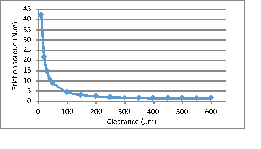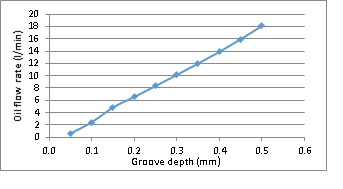groove depth. One can note that in real applications, the flow is fixed by the limit of the pump. The idea is to optimize the geometry of the friction disk to obtain an oil flow rate during an engagement less than or equal to the flow rate of the pump; otherwise, the cooling will be less efficient. The most critical state is the case with the lower clearance and the highest rotating velocity. For the lower clearance (10 µm), the flow rate and the torque decrease with the velocity. When the groove width is increased from 3 to 6 mm, the flow rate is increased by 121%, whereas the torque is decreased by 12%. The inclination of the groove has only a weak effect on the torque: when varying the inclination from 10° to 60°, the torque is reduced by 6% while the flow rate is increased by 142%.

Figure 1 – Friction torque versus clearance between disks.

Figure 2 – Total oil low rate versus groove depth.
CONCLUSION:
The parametric study gives a better understanding of the effect of each parameter. It presents a tool that allows optimizing the flow on a wet clutch in order to cool efficiently the system.
REFERENCES:
[1]. Iqbal S., Al-Bender F., Pluymers B. and Desmet W., “Mathematical Model and Experimental Evaluation of Drag Torque in Disengaged Wet Clutches”. Hindawi, Volume 2013, Article ID 206539.
[2]. Takagi Y., Nakata H., Okano Y., Miyagawa M. and Katayama N.“Effect of Two-phase Flow on Drag Torque in a Wet Clutch”. Journ. of Adv. Research in Physics 2, 021108, 2011.
[3]. Aphale C. R., Cho J., Schultz W. W., Ceccio S. L., Yoshioka T., Hiraki H., “Modeling and Parametric Study of Torque in Open Clutch Plates”. Journ. of Trib., Vol. 128, 422-430, 2006.
[4]. Yang L., Ma B., Ahmadian M., Li H. and Vick B., “Pressure Distribution of Multidisc Clutch Suffering Frictionally Induced thermal load”. Trib. Trans., 59:6, 983-992, 2016.